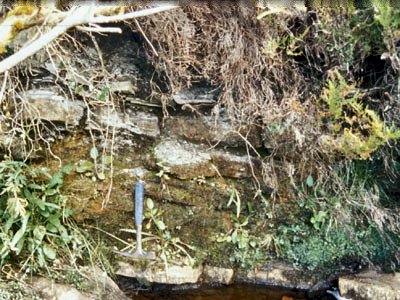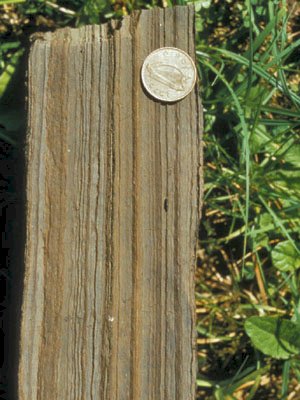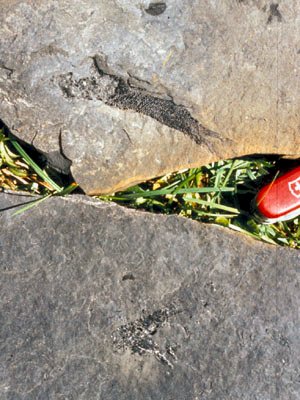Earth Science Conservation Review
| Sillees River, Glenasheevar | Fermanagh |

| Site Type: | Stream section |
| Site Status: | ASSI |
| Grid Reference: | H041538 |
| Google maps: | 54.43319,-7.9368 |
| Rocks | |
|---|---|
| Rock Age: | Carboniferous (Asbian) |
| Rock Name: | Leitrim Group, Meenymore Formation |
| Rock Type: | Limestone, Micritic limestone, Mudstone |
| Interest | |
| Fossil Groups: | Fish, Plant |
| Other interest: | marginal marine |
Summary of site:
This locality is important as one of only three sites in Northern Ireland yielding complete fossil fishes.
The few metres of rock in which the two fish horizons occur are mudstones with true laminations of very fine grained limestone best seen in the stream. Immediately above this section the rocks are obscured until a 1m thick bed of dolomite crops out. These rocks form part of the Meenymore Formation which, in turn, is part of the Leitrim Group. The discovery of the goniatite Beyrichoceras micronotum about 6m below the fish beds dates these rocks to the Asbian stage, around 337 million years ago.
The two fish horizons are separated by a little over 10cm of mudstone and are associated with plant remains (possibly ferns). The fish are all of similar size, either intact or disarticulated to various degrees. They lie quite close together in the bedding planes and all belong to the species Elonichthys serratus.
The rocks were formed in equatorial, shallow water, marine to brackish water conditions. The goniatites indicate fully marine conditions earlier, while the overlying dolomite is a clear indicator of high evaporation with the formation of concentrated brines - an arid inshore environment. The simplest interpretation for the fish horizons is that they represent a ‘mass kill' of a fish shoal entering, or overtaken by, anaerobic water conditions (i.e. water with too little dissolved oxygen to support animal life). Stagnant pockets of such water occur in hot and hostile coastal environments, particularly where large volumes of decaying plant debris are found. The fish would have asphyxiated and their corpses sunk to a lifeless sea bed where currents were their only likely disturbance.
This is a site of great importance in Northern Ireland and one of only a handful in Ireland. It is the only site producing well preserved Elonichthys and consequently of palaeontological significance for ichthyologists. The inshore environment, although at present yielding only a single fish species, is one of wider interest because land animals and plants could possibly be found here in future.
This unique site is known only to a few specialists but because it contains complete fossil fishes it would be a considerable magnet to commercial collectors were its whereabouts to become widely known. The outcrop in its present form is very limited and could be quickly and completely destroyed by intensive collecting. Its isolation could be an added incentive to the unscrupulous. Designation, while offering legal protection, would not guarantee continuous monitoring - which is why only general locality information is given here.
The few metres of rock in which the two fish horizons occur are mudstones with true laminations of very fine grained limestone best seen in the stream. Immediately above this section the rocks are obscured until a 1m thick bed of dolomite crops out. These rocks form part of the Meenymore Formation which, in turn, is part of the Leitrim Group. The discovery of the goniatite Beyrichoceras micronotum about 6m below the fish beds dates these rocks to the Asbian stage, around 337 million years ago.
The two fish horizons are separated by a little over 10cm of mudstone and are associated with plant remains (possibly ferns). The fish are all of similar size, either intact or disarticulated to various degrees. They lie quite close together in the bedding planes and all belong to the species Elonichthys serratus.
The rocks were formed in equatorial, shallow water, marine to brackish water conditions. The goniatites indicate fully marine conditions earlier, while the overlying dolomite is a clear indicator of high evaporation with the formation of concentrated brines - an arid inshore environment. The simplest interpretation for the fish horizons is that they represent a ‘mass kill' of a fish shoal entering, or overtaken by, anaerobic water conditions (i.e. water with too little dissolved oxygen to support animal life). Stagnant pockets of such water occur in hot and hostile coastal environments, particularly where large volumes of decaying plant debris are found. The fish would have asphyxiated and their corpses sunk to a lifeless sea bed where currents were their only likely disturbance.
This is a site of great importance in Northern Ireland and one of only a handful in Ireland. It is the only site producing well preserved Elonichthys and consequently of palaeontological significance for ichthyologists. The inshore environment, although at present yielding only a single fish species, is one of wider interest because land animals and plants could possibly be found here in future.
This unique site is known only to a few specialists but because it contains complete fossil fishes it would be a considerable magnet to commercial collectors were its whereabouts to become widely known. The outcrop in its present form is very limited and could be quickly and completely destroyed by intensive collecting. Its isolation could be an added incentive to the unscrupulous. Designation, while offering legal protection, would not guarantee continuous monitoring - which is why only general locality information is given here.
| Enlander, I., Dempster, M. & Doughty, P., 2025. Sillees River, Glenasheevar, County Fermanagh, site summary. [In] Earth Science Conservation Review. https://www.habitas.org.uk/escr/summary.php?item=119. Accessed on 2025-04-03 |
| Previous Site | Next Site |

